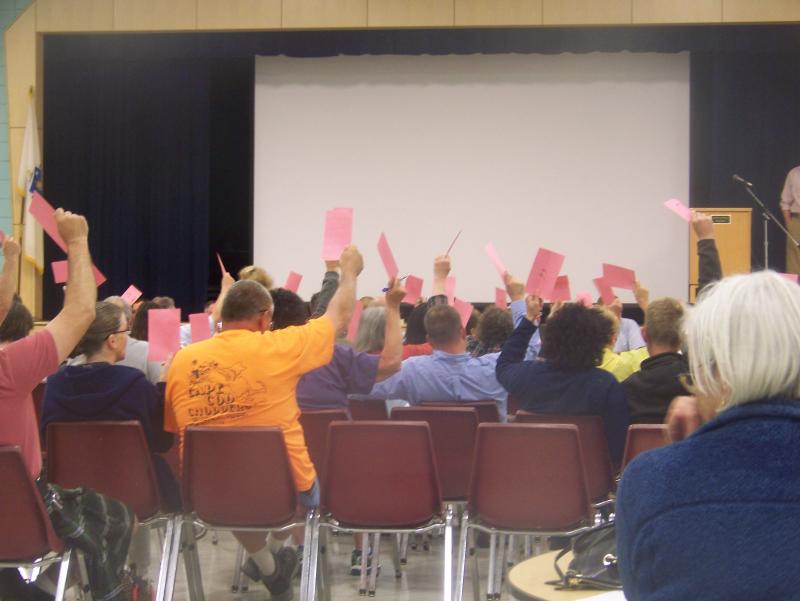Rochester residents approve $19.5 million budget at Town Meeting
Residents voted on 23 agenda items during the annual Town Meeting on Monday at Rochester Memorial School, including a $19.5 million budget and nearly $150,000 to remove snow this past winter.
Residents approved transferring $85,000 from the Town Stabilization Fund and $61,591 from the Free Cash account to pay off the snow and removal account deficit. The town budgeted $68,000 for winter clean-up. Per state law, the snow and ice account is the only one communities may spend overspend.
Should state or federal funds become available for storm relief, that money will be returned to the Stabilization Fund, otherwise known as the town's rainy day account.
Residents also voted in favor of a $19,593,758 budget for fiscal year 2016. The budget is $563,772 more than last year’s budget, which marks a 2.9 percent increase.
Finance Committee Chair Kris Stoltenberg credited the School Committee and administrators for reducing the school’s budget request by 50 percent in a tough fiscal year.
“I can’t thank them enough,” Stoltenberg said. “They came back and dramatically reduced their initial request.”
Between Rochester Memorial School, the Old Rochester Regional district and Old Colony, voters approved a total education budget that was $321,804 up from last year. The total spent on education was $11.5 million.
Stoltenberg said the Police Department’s budget was increased $43,400 compared to last year so a new officer could be hired. With one officer on leave and another about to join the state police, Soltenberg said the department’s overtime budget would have cost $60,000 unless a full-time officer was hired.
Voters questioned a $5,000 raise for Fire Chief Scott Weigel that paid $42,627 for the part-time position.
Stoltenberg said the town should move toward making the fire chief a full-time position, but funding the change under current budget conditions made that fiscally impossible.
“In the future, it’s in the town’s interest,” Stoltenberg said.
The Finance Committee members added the $5,000 to Weigel’s salary to bring it in line with surrounding communities.
Voters did not vote on an agenda item that sought a cost savings by amending the town’s personnel bylaw. If approved, the amount of time when some employees are eligible for a raise would have increased. Currently, non-union, non-contract employees received performance reviews yearly, and employees with good reviews receive a three percent raise.
Highway Surveyor Jeff Eldridge made a motion, “to postpone this article indefinitely to give the Board of Selectmen the time necessary to fix all of the deficiencies in the compensation plan.”
There are 10 wage levels for employees. Once they reach step 10 the raises stop. The new bylaw would have increased the wait time between steps four to seven to two years. Employees on steps seven to nine would have had to wait three years before getting a raise. Employees on steps one through four would still receive annual raises.
“The personnel bylaw is proposed in order to save the town money by not having annual three percent employee increases,” Selectmen Chair Richard Nunes said. “The board acknowledges that some employees are not in favor of this proposal.”
Nunes said the change is modeled on personnel guidelines developed by the federal government.
Of the 15 town employees covered under the personnel bylaw, four would have been affected if it changed.
Voters agreed to language changes in the Limited Commercial District bylaw that allows for developers to propose “mixed use” developments.
Located in the town’s center, the district encompasses Plumb Corner Mall and undeveloped adjacent land, as well as parcels on New Bedford Road, located across the street from the post office. The size of the district will remain the same.
“[The bylaw] introduces architectural design guidelines to promote development that reflects the character of the town of Rochester,” said Richard Cutler, chair of the committee that drafted the changes. “It we don’t manage growth, it will be managed by outside entities.”
The new language gives developers the option to build residential and commercial structures in the same lot. Also, the changes are designed to encourage diverse housing and pedestrian friendly features.
Other changes require developers to submit designs that reflect the town’s architectural character. Site plans reviews require developers to present detailed proposals before the Planning Board, and those reviews will include public hearings where residents and abutters may ask questions.















